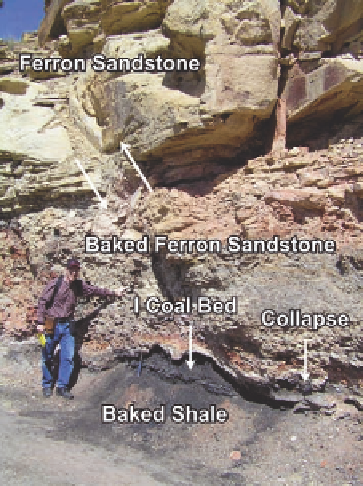Geology Reference
In-Depth Information
B
A
Figure 9.1.3. Possible outcrops of GASs. (A) Red clinker (light color) surrounding an anthracite coal-fire gas vent
at the Centralia mine fire, Pennsylvania. Hot gas altered the Pennsylvanian Llewellyn formation (black shale)
surrounding the vent. Glenn B. Stracher is measuring the vent temperature with a thermocouple probe. A LaMotte
hand pump on the ground was used to collect a gas sample for analysis. (B) Baked Ferron clinker (sandstone) and
red-black nonmarine shale within the Ferron Sandstone Member of the Mancos Shale, Emery coalfield, Utah. Note
the reverse fault in the Ferron sandstone and its collapse into the area where the I coal bed completely burned, at
knee level to G.B. Stracher. From Stracher et al., 2006, photo A; 2005b, photo B with modifications, permission of
the Geological Society of America.
condensed from the gas reacts with the substrate, thereby altering the chemical composition of the liquid (and
substrate) prior to mineralization, the reaction path may be
Reacts with
substrate
Y
Condenses
X
ð
g
Þ !
X
ð
l
Þ!
ð
l
Þþ
Altered substrate
ð
:
:
Þ
9
1
4
Solidifies
Isochemical
Y
Y
ð
l
Þ!
ð
Þ
s
where the reaction of X(l), perhaps an acidic solution, with the substrate forms a different liquid Y(l) which then
isochemically solidifies to form the mineral Y(s). On the microscopic scale of observation, the former presence of a
liquid Y(l) may be revealed by vesicles observed in SEM images (Figure 9.1.4; Stracher et al., 2005a) or mineral
chemistry, as discussed below.
If Y(s) is hydrous and it dehydrates of hydrates, perhaps due to a temperature increase or decrease, respectively, at
the vent, then expression 9.1.4 becomes
Condenses
Reacts with
substrate
Y
ð
Þ !
ð
Þ!
ð
Þþ
X
g
X
l
l
Altered substrate
Solidifies
Isochemical
Y
Y
ð
l
Þ!
ð
s
Þ
ð
9
:
1
:
5
Þ
Dehydrates
Hydrates
Y
ð
s
Þ!
Z
ð
s
Þ


